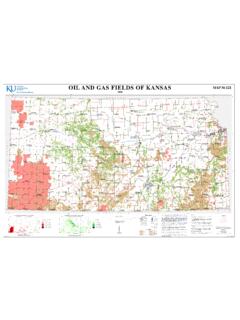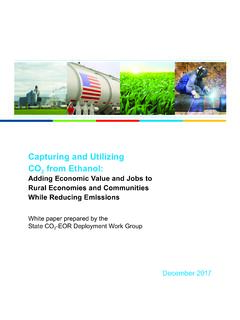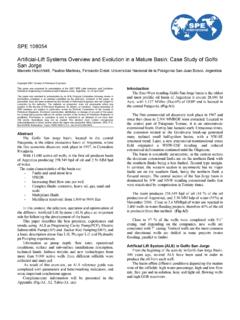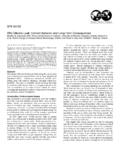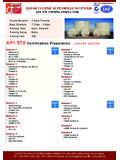Transcription of SPE 152596 Hydraulic Fracturing 101: What Every ...
1 SPE 152596 Hydraulic Fracturing 101: What Every Representative, Environmentalist, Regulator, Reporter, Investor, University Researcher, Neighbor and Engineer Should Know About Estimating Frac Risk and Improving Frac Performance in Unconventional Gas and Oil Wells. George E. King, Apache Corporation Copyright 2012, Society of Petroleum Engineers This paper was prepared for presentation at the SPE Hydraulic Fracturing Technology Conference held in The Woodlands, Texas, USA, 6 8 February 2012. This paper was selected for presentation by an SPE program committee following review of information contained in an abstract submitted by the author(s).
2 Contents of the paper have not been reviewed by the Society of Petroleum Engineers and are subject to correction by the author(s). The material does not necessarily reflect any position of the Society of Petroleum Engineers, its officers, or members. Electronic reproduction, distribution, or storage of any part of this paper without the written consent of the Society of Petroleum Engineers is prohibited. Permission to reproduce in print is restricted to an abstract of not more than 300 words; illustrations may not be copied. The abstract must contain conspicuous acknowledgment of SPE copyright.
3 Abstract Identification of risk, the potential for occurrence of an event and impact of that event, is the first step in improving a process by ranking risk elements and controlling potential harm from occurrence of a detrimental event. Hydraulic Fracturing has become a hot environmental discussion topic and a target of media articles and University studies during development of gas shales near populated areas. The furor over Fracturing and frac waste disposal was largely driven by lack of chemical disclosure and the pre-2008 laws of some states. The spectacular increase in North American natural gas reserves created by shale gas development makes shale gas a disruptive technology, threatening profitability and continued development of other energy sources.
4 Introduction of such a disruptive force as shale gas will invariably draw resistance, both monetary and political, to attack the disruptive source, or its enabler; Hydraulic Fracturing . Some anti-frack charges in media articles and university studies are based in fact and require a state-by-state focused improvement of well design specific for geology of the area and oversight of overall well development. Other articles have demonstrated either a severe misunderstanding or an intentional misstatement of well development processes, apparently to attack the disruptive source. Transparency requires cooperation from all sides in the debate.
5 To enable more transparency on the oil and gas side, both to assist in the understanding of oil and gas activities and to set a foundation for rational discussion of Fracturing risks, a detailed explanation of well development activities is offered in this paper, from well construction to production, written at a level of general public understanding, along with an initial estimation of frac risk and alternatives to reduce the risk, documented by literature and case histories. This discussion is a starting point for the well development descriptions and risk evaluation discussions, not an ending point.
6 Introduction to Risk There are no human endeavors without risk. Risk management is the identification, assessment and prioritization of risks followed by coordinated and economical application of resources to minimize, monitor and control probability and/or impact of unfortunate effects (Wikipedia). At a minimum, basic risk concerns are: People, Economic Loss (to all concerned), Environmental Damage and Reputation Loss. Figure 1, a standard loss matrix used by Apache Canada in the Horn River development (DeMong, 2010), is a good starting place for the discussion. Consequences run from slight and practically unavoidable to severe and avoidable at all costs.
7 This paper, for purposes of brevity, will focus solely on risk to the environment from Hydraulic Fracturing operations, 2 SPE 152596 starting with transport of materials and ending when the well is routed to the production facilities and gas sales begin. The form of Figure 1 will be expanded and comments and descriptions of problems that begin with drilling, well construction and production will be discussed, but their risk assessment is in a separate category.
8 Many well development problems are blamed on Fracturing , but have nothing to do with the Fracturing process. Some of these excluded problems are real and are definitely worthy of inclusion in the discussion, to help define the boundaries of the Fracturing risk and as a starting point for further understanding and work. The initial assumption for the risk matrix is that the well is new and was constructed correctly (to design requirements) so that all producible formations are securely isolated behind the barriers of casing (pipe) and competent cement. No assessment of Fracturing risk is made here for wells outside of the design requirements.
9 The justification for this assumption is that the vast majority of Fracturing is the first major stimulation in a well and occurs immediately after completing a new well. If an older well is re-fractured, then an assessment of well integrity and a separate risk analysis would be required. Introduction to Fracturing Hydraulic Fracturing and horizontal wells are not new tools for the oil and gas industry. The first Fracturing experiment was in 1947 and the process was accepted as commercial by 1950. The first horizontal well was in the 1930 s and horizontal wells were common by the late 1970 s.
10 Millions of fracs have been pumped (Society of Petroleum Engineers estimate million fracs world-wide and over 1 million in the US) and tens of thousands of horizontal wells have been drilled over the past 60 years. Even shale gas, especially from the Devonian shales (including Marcellus), are not new producing intervals. Devonian shales are the source rocks for the shallow oil wells of eastern Pennsylvania, where Mr. Drake drilled the first US oil well after noticing a number of natural seeps of oil and gas in the area. Concentrated shale Fracturing research was kicked off by a Department of Energy (DOE) grant in the 1970 s.
